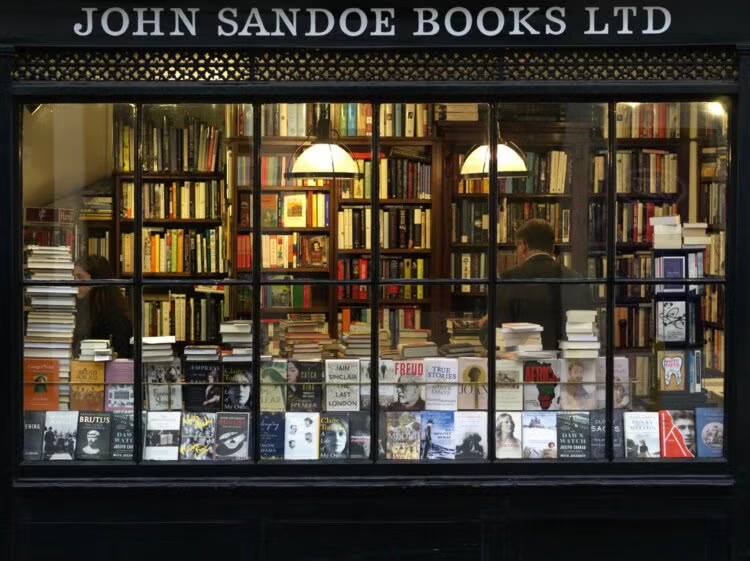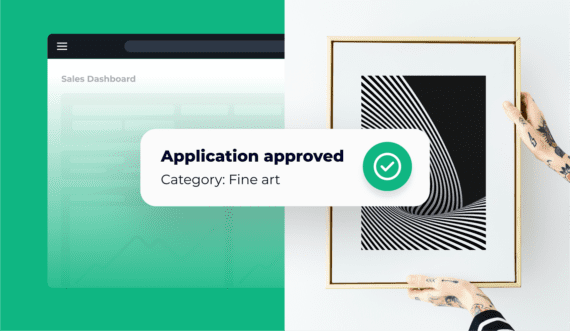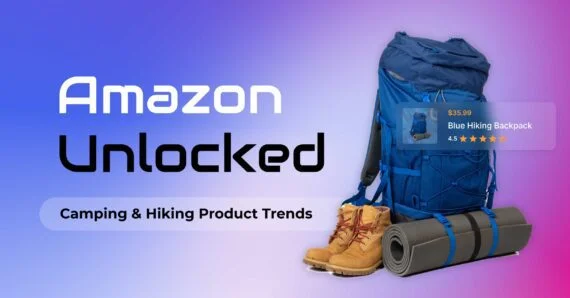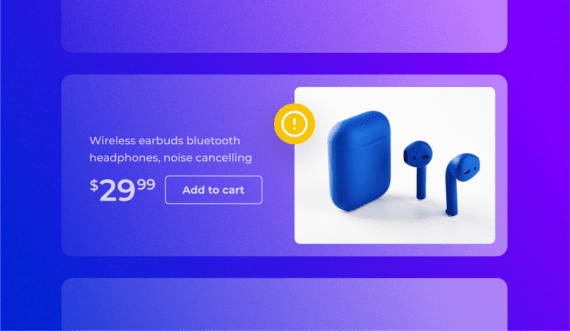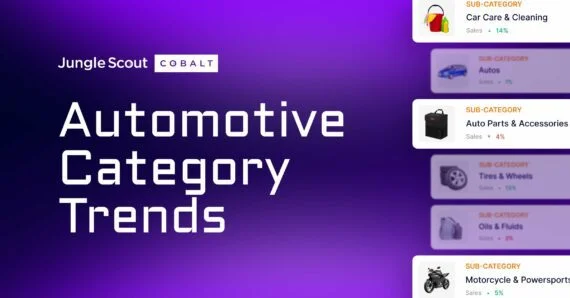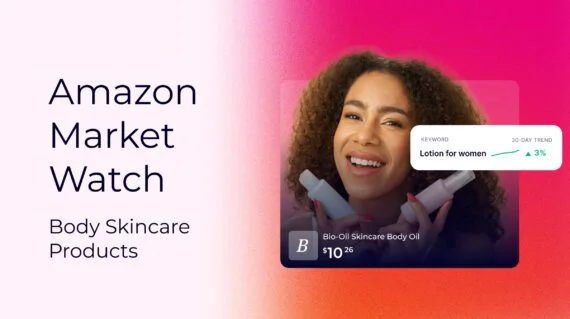Selling books on Amazon is a fantastic way to make some cash — and even to start building an Amazon business.
The best part is, you don’t need a lot of money to start. In fact, you can get started for free by selling your old books that are collecting dust.
While this article is geared more towards those who want to make money reselling used books on Amazon, this is also great for authors or those looking to sell new books on Amazon.
Before you start learning how to sell books on Amazon, make sure you have your Amazon Seller Central account created and choose how you’ll want to fulfill your orders — either FBA or FBM (or both!)
How do you find books to sell on Amazon?
A great place to start selling books on Amazon is by selling old books that are already in your possession — but that will only get you so far as eventually you’ll sell out, or, the books you have are not good for resale.
And if you’re wondering, yes, reselling used books (and other products on Amazon) is perfectly legal and okay to do so on Amazon. Though keep in mind that your account may be restricted in selling certain publications or authors — we’ll go over this more in the “How to sell books on Amazon” section below.
The best part about selling used books on Amazon is that you can typically source them for pennies on the dollar. Especially when you find something like a textbook for $1 at a library sale that sells for $50+ used on Amazon.
Here are six of the most popular methods for finding used books to resell on Amazon.
1. Sell your own books
This one is probably the simplest way to find books to sell and it’s how many sellers get started. Look around your house and see if you have some old books collecting dust.
Consider textbooks, rare topics, niche topics such as old comic books, or other non-fiction books. Mass-produced fiction books tend to lose their value faster than non-fiction books so they’re typically not worth selling on Amazon.
2. Book/library sales
Book sales can be kind of like hunting for treasure. Plus, there’s always a book sale going on somewhere, especially at libraries.
Head to these sales with a book scanner and look for some picks that would be good to list on Amazon. By using a bluetooth scanner along with a book scanning app, you’ll be able to find profitable books much faster than the competition at these sales.
Scanning apps help you figure out your potential profit on Amazon after product costs and Amazon fees.
Need help finding local book sales? Check out booksalefinder.com.
Uncover the best Amazon scanner app.
With an Amazon seller scanner app, retail arbitrage sellers can quickly and efficiently find profitable products in nearly any store.
3. Online arbitrage
Don’t feel like going out? Some sellers look on websites other than Amazon for books with prices lower than what you could sell the same book for on Amazon. This is called ‘online arbitrage.’
All you do is purchase the book from the one website for a low price, wait for it to arrive, and then list it on Amazon for a higher price. You can find used books for sale on sites such as eBay, Facebook Marketplace, Barnes & Noble, and many others.
Note: We don’t suggest reselling new books on Amazon without having a legitimate source such as a publisher or distributor. We’ll go over more of that later in the article.
4. Bulk purchase/wholesale
You can often buy entire lots of books online for super low prices. You can buy full lots or even truckloads of used books on eBay, Craigslist, and Facebook listed at low rates. If you go this route, make sure you’re buying books that have not been sorted or scanned. If so, you could be buying another Amazon sellers ‘duds’ that are not profitable for Amazon.
5. Estate/closing sales
Estate sales, closing sales, and moving sales are awesome ways to find books since large collections of books will be sold all at once. Typically, you can make offers on entire collections for pennies on the dollar.
To find local estate sales, visit www.estatesales.net
6. Free books
Check out Craigslist or Facebook Marketplace; there is always someone who is looking to offload books at no charge. All you have to do is go get them.
Just be careful, as sometimes these free books could be listed by other sellers who are getting rid of the books that don’t sell.
What kind of books sell best on Amazon?
Finding books to list on Amazon is usually pretty easy. However, you don’t want to spend your time listing books that no one will buy. That’s why it’s important to know how to find the right books to sell on Amazon.
Books that sell well on Amazon:
- Niche books. Books that had low print runs and are a part of a larger collection do well on Amazon thanks to a lack of competition. For example, there is money to be made purchasing Dungeons & Dragons books on eBay and reselling them on Amazon.
- Comic books. You can sell comic books on Amazon, too. Both single issues and graphic novels perform well on Amazon, and if you have collectible issues they can fetch a decent profit.
- Collectibles. First edition books, signed books, and any other book that could be considered “collectible” are also popular on Amazon. Again, be sure to check if you’re allowed to sell any “collectible” you come across on Amazon.
- Non-fiction. Overall, non-fiction performs a lot better than fiction on Amazon — in the resale market. That’s not to say that fiction does poorly, but in my experience, fiction books tend to lose their value faster than non-fiction books.
- Hardcovers. Naturally, hardcovers have higher prices than paperback books and tend to hold their value better.
How to sell textbooks on Amazon
If there was a “gold standard” of used books that you can sell on Amazon, it’d definitely have to be textbooks.
Textbooks are always in high demand, especially during the fall and spring, and tend to have high prices — even old editions!
The only drawback with textbooks is that sometimes publishers “brand gate” their books to prevent non-certified sellers from selling new or used copies so always be sure to check if you’re able to sell a particular book in your seller account before buying.
What types of books don’t sell well on Amazon?
- Fiction. As I noted above, fiction doesn’t sell well on Amazon. I believe there are a few reasons for this. First, fiction books have larger print-runs than non-fiction books, meaning that there are more copies in circulation. Also, readers are less likely to hold onto a book of fiction they’ve read than a book of non-fiction which they can still reference. Finally, fiction books have cheaper cover prices.
- Children’s books. Another type of book people tend to get rid of quickly once they’re done reading them are children’s books. Children’s books tend to have much lower prices, as well, meaning that it’s tough to turn a profit when selling them competitively.
- Popular new books. New books — even new, hardcover, non-fiction books — are not profitable for resellers on Amazon. The chief reason for this? Because you have to compete against Amazon! Anytime Amazon is selling a book, it’s going to be tough to beat their prices.
How to estimate your sales and profit when selling books on Amazon
Now that you know where to find books and the types of books to sell, how do you know what you’re selling is going to be profitable? Well, before buying any books to resell, you need to look at a few things.
- You need to check the rank of the product. If it has a low Best Sellers Rank, the book won’t sell at all.
- You need to determine your profitability based on the selling price and your buy cost.
Here are a few tricks you can use to sort through the clutter.
Check the book’s Best Seller Ranking
Every single product on Amazon gets a ‘‘Best Sellers Rank’ (BSR). The lower a product’s BSR, the more often that product sells on Amazon.
For example, a book ranked #1 on Amazon sells hundreds of copies per day. Meanwhile, a book ranked #1,000,000 might not sell a single copy for months.
A book’s best-seller ranking can be found on the book’s page listing in the product details.
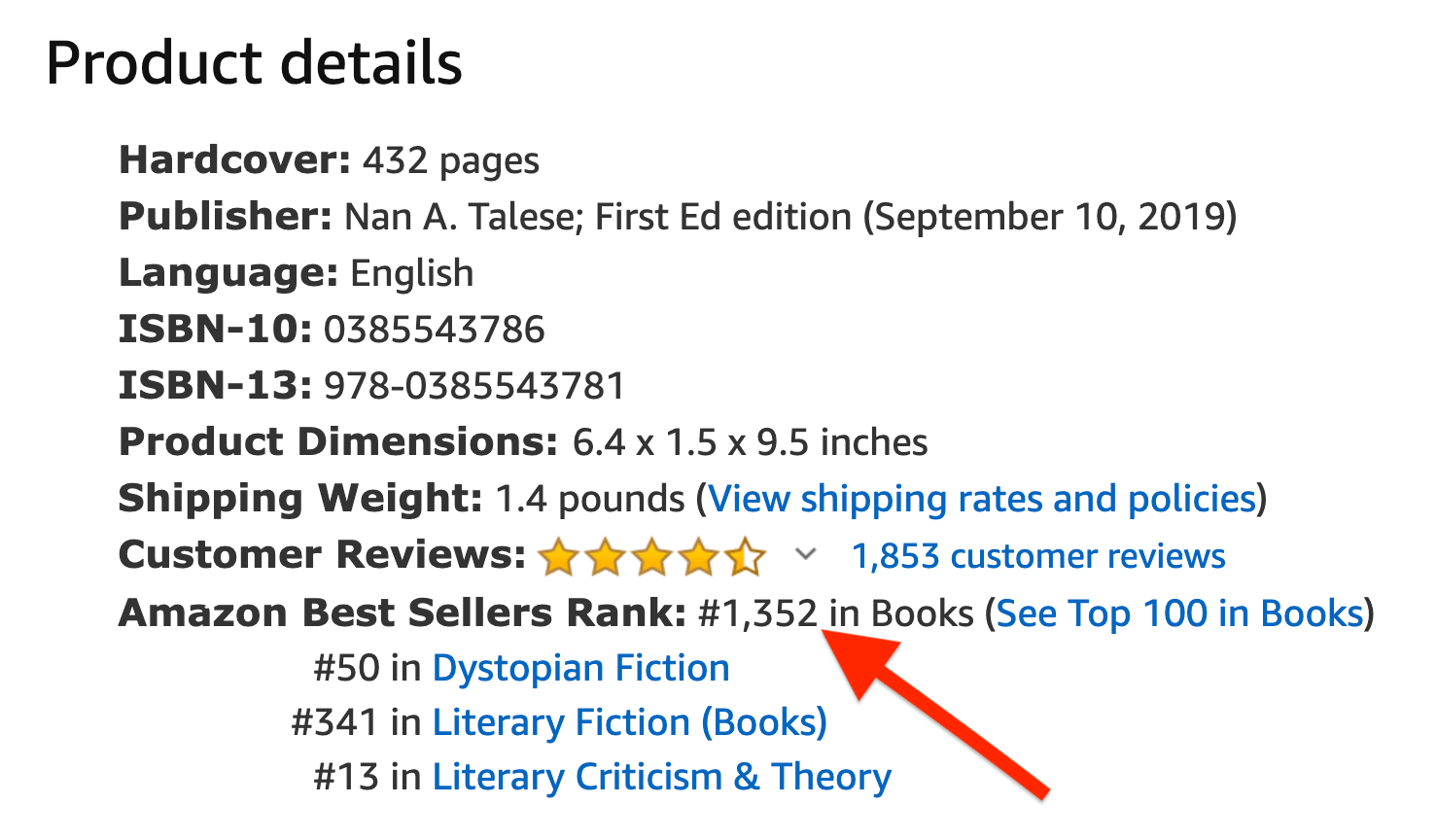
In my experience, you want to sell books that have a BSR lower than 100,000. That means there is a pretty good chance that your book will sell within a week or so — depending on how many other sellers are on the listing.
Note: The Amazon Best Sellers Rank you need to focus on is the BSR for the Books category. You can ignore the BSRs for the subcategories.
Estimate the book’s likelihood to sell
There are a few tools you can use to estimate how likely a book is to sell on Amazon and some that will show you your potential profits.
- Jungle Scout’s free Estimator tool. Simply put in a book’s BSR, the market you’re selling it in, and the category. From there, the Sales Estimator tells you the monthly sales for that product. For example, if a product has 3,000 sales per month, it sells about 10 copies per day.
- Jungle Scout Extension. The Extension shows you the sales history for a single product as well as the estimated sales for an entire page of search results as well. The Extension also features a graph on the product detail page that shows how the BSR and price has changed over time.

- Book scanners. Many book sellers use a handheld scanner to help them while they’re looking for inventory. To make life really easy for yourself, you can always use Amazon’s mobile seller app instead. It comes with a scanner of its own that gives you the product price, FBA fees, approximate profits, BSR, total number of sellers, and official Amazon category.
- Book selling app. If you are serious about selling books on Amazon, many sellers use a specific book scanning app to help them find profitable books to resell. Paired with a bluetooth scanner, you’ll be able to sort through hundreds of books in a short period of time.
Find the most profitable books to sell on Amazon.
Jungle Scout Extension gives you instant access to a product’s sales history.
Estimate your profit
If you decide a book is good to sell based on rank, next you need to determine your profit. As mentioned above, you can use a book scanner app or the Amazon Seller app to help determine your profitability — which are your best options.
Another option is to use Amazon’s free FBA Revenue Calculator. Simply paste the ISBN of the book you want to sell, enter your costs, and the calculator will show you what fees you’ll pay and your potential profit.
Note: If you don’t mind storing books in your own home for a longer period of time, or paying the additional storage fees (if you’re an FBA seller), then you can list books that sell more slowly. Just go with what you’re comfortable with!
How much does it cost to sell books on Amazon?
Like most online platforms, Amazon has certain fees you have to pay to sell on their platform.
Here is a brief description of the fees you should expect.
Individual fee or subscription fee
When selling on Amazon, sellers have an option to create an individual seller account or a professional seller account. Individual sellers are sellers who sell 40 or less products per month. If you are an individual seller, there is no monthly subscription fee, but you do have to pay an additional $0.99 per-item fee after each sale.
If you sell (or plan to sell) more than 40 products per month, go with the professional seller account as you’re not charged and do not have to pay the $0.99 per-item fee. However, there is a $39.99 subscription fee every month. This fee is deducted from your account balance or charged to a credit card you put on file.
READ MORE | Amazon Individual vs. Professional Seller Plans: The Complete 2024 Guide
Referral fee
When you sell a book on Amazon, Amazon takes 15% of the sale price. For example, if you sell a book for $10, the referral fee will be $1.50. This fee is subtracted from the proceeds after a sale is made, so you don’t have to pay it upfront.
Closing fee
Media products such as books, DVDs, CDs, and Blu-Ray, come with a flat $1.80 fee per sale, and only sellers who focus on selling these products need to worry about these fees. So, if you sell books, you will be paying the closing fee. Non-media product categories will not pay this fee.
Like the referral fee, the closing fees are deducted from the proceeds of the sale so you do not need to pay these fees in advance.
Shipping costs
In addition to the two types of seller plans, there are also two ways to fulfill your orders on Amazon: Fulfillment by merchant (FBM) or Fulfillment by Amazon (FBA).
A FBM seller is responsible for shipping their own products once a sale is made. Your shipping costs depend on your carrier, resources you use to ship products, and the cost of labor.
A FBA seller uses Amazon’s fulfillment network to store, pick, pack, and ship their products. This comes with an FBA fee that replaces the costs you’d normally spend shipping goods. Your FBA fee is determined by the size and weight of the book sold.
You can learn more about FBA fees in our in-depth article on the subject. However, it’s worth noting that FBA fees tend to be much less than what it would cost to ship your own books. Plus, Amazon does all the work for you! It’s a win-win.
Storage fees: When you use FBA to fulfill your products, you will also be charged a storage fee for keeping your inventory in Amazon’s fulfillment centers. For any inventory in an Amazon warehouse at the end of the month, Amazon charges you a monthly storage fee. Amazon also has a FBA aged inventory surcharge for inventory stored in fulfillment centers for over 180 days.
Is selling books on Amazon worth it?
Yes, selling books on Amazon is definitely worth it if you can find a good source of profitable books.
How is it worth it? Let’s look at some of the data from Jungle Scout’s State of the Seller Report.
- 8% of book sellers on Amazon have reached lifetime profits between $100,000-$500,000
- 18.9% of book sellers have profit margins of 26%-50%
- It took 21% of book sellers to be profitable in under 3 months
As mentioned above, one of the biggest benefits to selling used books on Amazon is that you can typically buy used books or very cheap — or even get them for free in some cases.
At library or estate sales looking for books, they want to get rid of as much as they can. Don’t be surprised if you see books selling for as low as $0.25.
Selling new vs. used books on Amazon
Clearly throughout this article, we’ve talked about selling used books on Amazon — but what about new books? It is certainly possible to sell brand new books on Amazon, especially if you’re an author who wants to sell their book on Amazon.
You can also self-publish your own books using Amazon KDP!
New books
The only time we’ll recommend selling new books on Amazon is if you are the author, or you have explicit permission by the author, publisher, or distributor to sell that book on Amazon. Reselling new books the same way we talk about selling used books is possible, but many times the book will be restricted to sell without approval or unprofitable. If you can find a legitimate source such as a distributor or publisher to purchase the books at wholesale cost to resell, that is when you’ll see higher profit margins.
Used books
Selling used books on Amazon is so desirable for many sellers because they’re easy to source and typically low cost to purchase. As mentioned, you can find used books for pennies on the dollar and resell them for near, or even above, the original MSRP. There are millions of books in circulation, so there are nearly endless opportunities to source profitable used books to sell online.
How to sell books on Amazon
Once you become registered to sell on Amazon, you can start listing your books.
The easiest way to do this is to go to the actual product detail page for the book you want to list. That’s right — you can actually list your books from the Amazon page itself instead of creating an entirely new listing. Then, once you list your book, it appears on the same listing along with the other sellers.
Here’s an example:
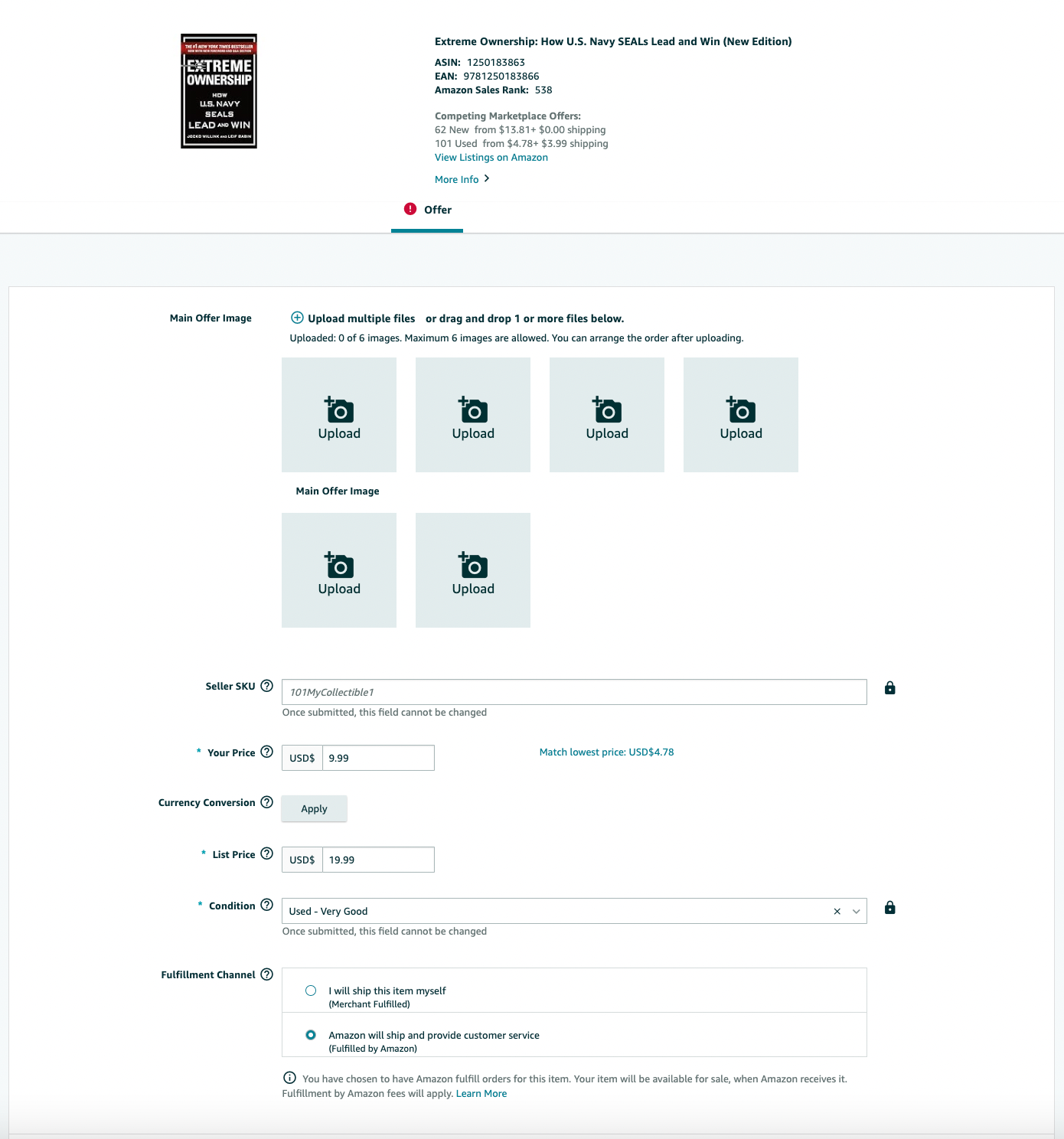
To access the product listing page, type in the book’s ISBN (which is the book’s registration code) under “Add Products” in Seller Central or on the Amazon Seller App. Or, if you know the books ASIN (Amazon Standard Identification Number), you can use that instead.
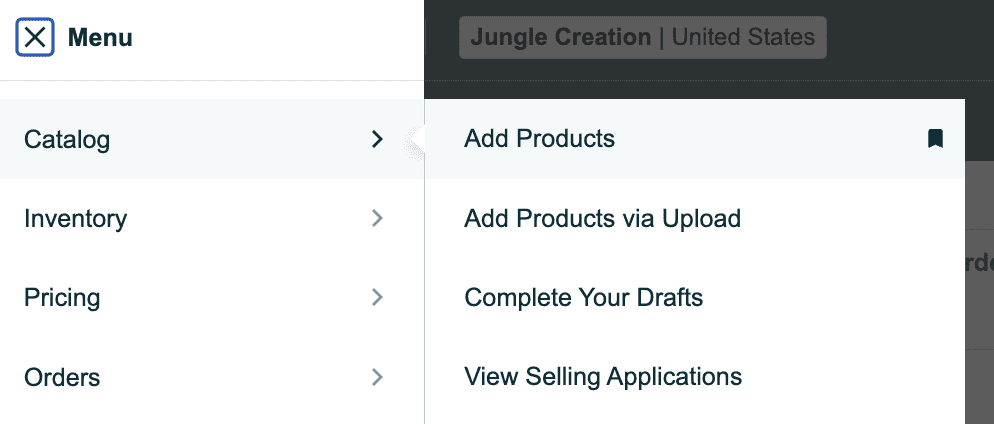
You can usually find the ISBN either on the barcode or somewhere inside the book’s dust jacket.
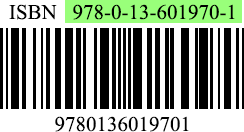
However, if the book was printed before 1970, it won’t have an ISBN. In that case, you’ll have to enter the title manually.
Scroll down to the product details on the listing of the book you want to sell to find the ASIN.
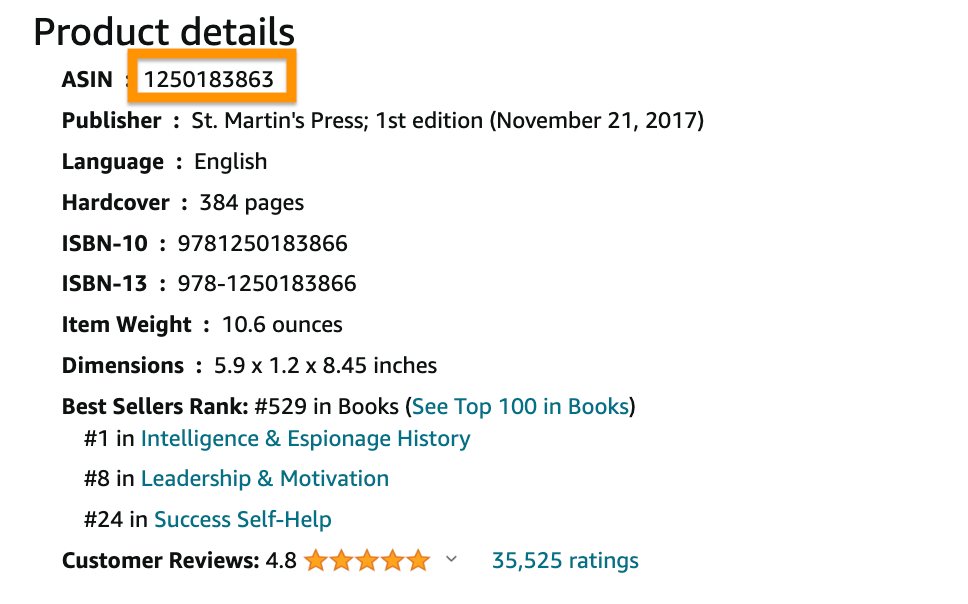
Then search for that book in Seller Central.
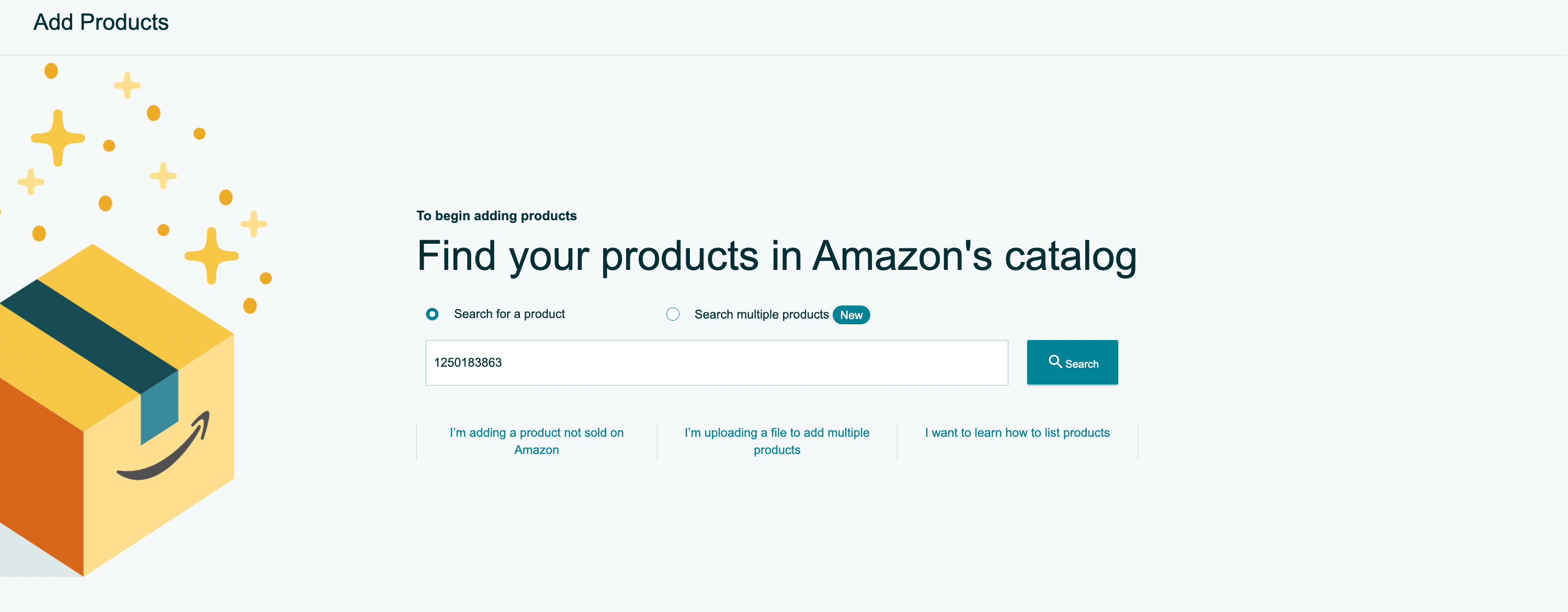
On the next page, choose the condition of the book then click “Sell this product.”
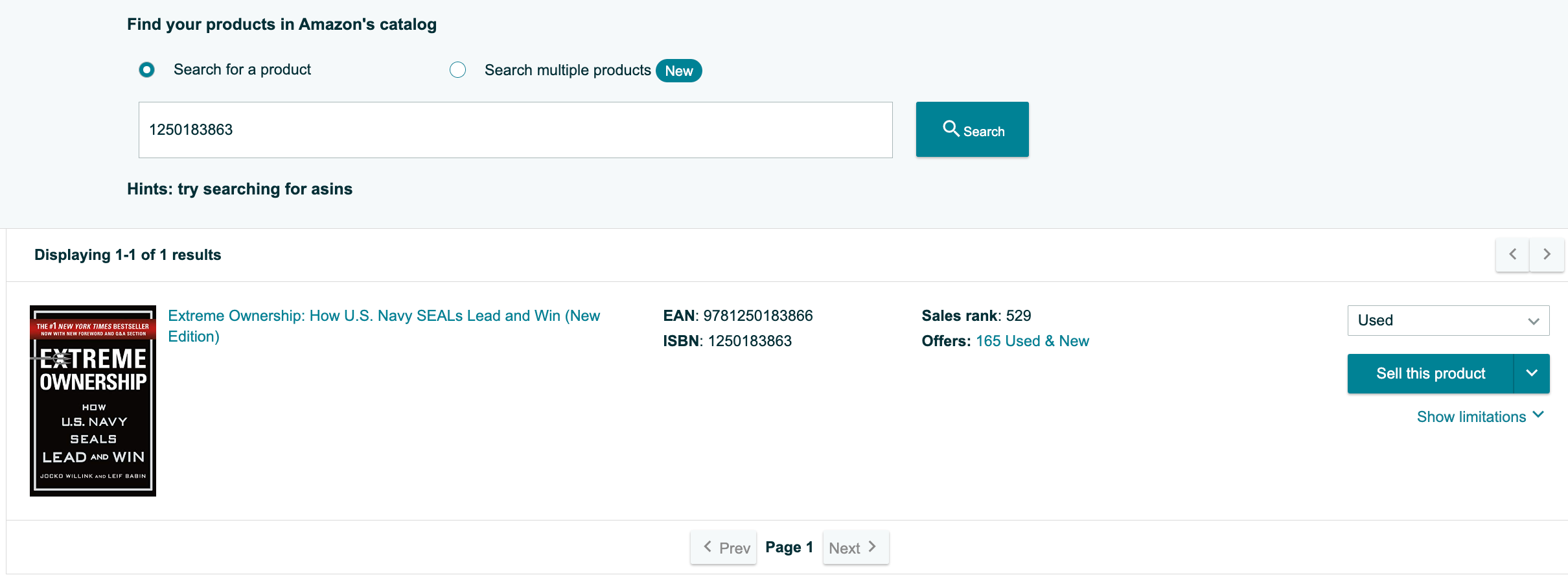

From there, enter the following information:
- SKU. This is your own personal code for the book. This can be whatever you want it to be, though it’s best if it’s something that will help you remember it. If you leave it blank, Amazon randomly generates one for you.
- Price. I recommend pricing the book based on the condition of the book. For example, books of ‘Acceptable’ quality usually sell for less than books of ‘Very Good’ value. Don’t automatically match the lowest price as it may cause a ‘race to the bottom.’ If your book is in good condition, it will usually sell even if there is a cheaper, lower quality option.
- Quantity. If you have more than one copy of a book, enter the total quantity here. Otherwise, it defaults to one unit.
- Condition. There are five conditions for Amazon books: ‘New’, ‘Like new’, ‘Very good’, ‘Good’, and ‘Acceptable’. If you can sell Collectible books (see FAQs), you will also have options for: Like new, Very good, Good, and Acceptable books. I don’t recommend ever listing a book in ‘New’ condition—even if it is in perfect condition. This is because you may be reported by the publisher or Amazon may request an invoice.
- Fulfillment Channel. FBM or FBA (see above in this article for the difference).
Once you enter that information, one of two things will happen:
- FBM. If you selected to sell the book FBM, your listing for the book will appear on the book’s product listing page in 15-30 minutes. All you have to do is wait for it to sell.
- FBA. If you selected to sell the book FBA, you have to prepare the book to ship to Amazon. It typically takes 1-2 weeks for your inventory to arrive at the destination fulfillment center. Then, it will take Amazon’s staff another three days to a week to unpack the inventory and distribute it to their network. This time could be longer if it’s a particularly busy period for Amazon, like the holiday season.
Selling books on eBay vs. Amazon
When it comes to selling books on Amazon vs eBay, personally, I feel Amazon is the better option. I’ve sold books on both platforms and I’ve had a lot more success with Amazon.
Here are a few reasons why Amazon is better than eBay:
- Inventory. You don’t have to hold your own inventory. Amazon keeps your inventory for you in their fulfillment centers and ships the products for you (FBA).
- BSR. Amazon gives each book a best-seller ranking. You can use this metric as a guide to estimate how likely a book is to sell on Amazon. This saves you a ton of time.
- Traffic. Amazon has more than double the online traffic of eBay with less than 1/10th of the sellers eBay has. That means a lot more opportunity for you.
Earn money by selling books on Amazon
We hope this article helped you understand how to sell used (and new) books on Amazon! Do you have more questions about the process or other tips that we didn’t include? Share them in the comments below; we’d love to hear them!
Start selling books on Amazon.
Learn more about how you can use Jungle Scout to launch, grow, and run your Amazon business.
Brian Connolly is an Amazon seller, ecommerce expert, and writer for Jungle Scout. He lives in the New Jersey Shore area with his wife and cat. When he isn’t writing advice online for aspiring and experienced Amazon sellers for Jungle Scout, he spends his free time boating, fishing, and selling boating-themed items on his Amazon business.

